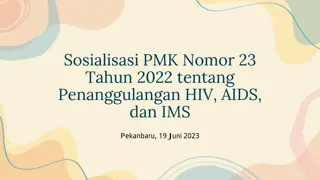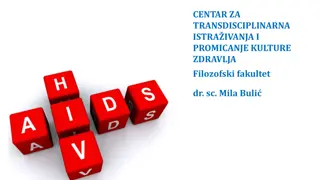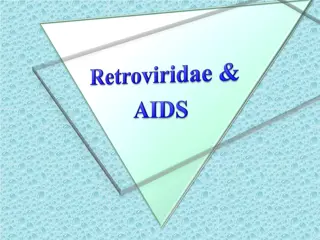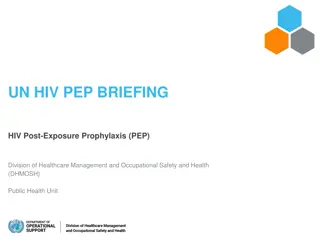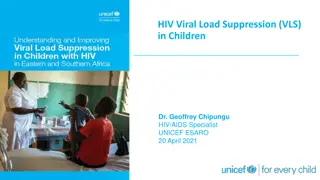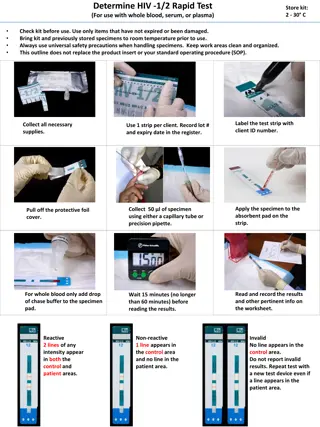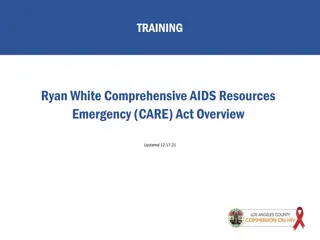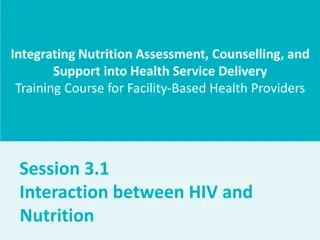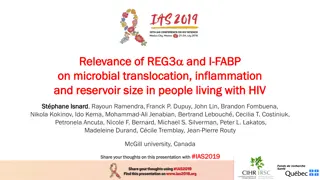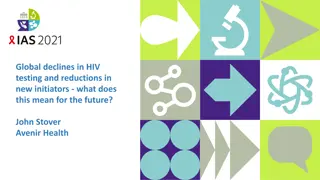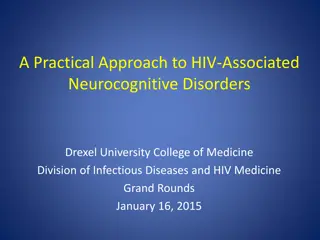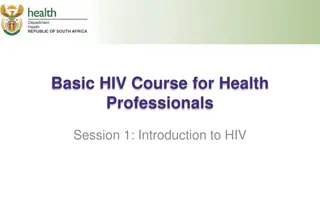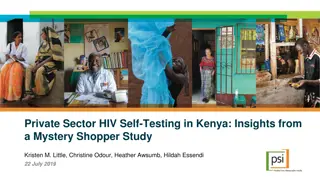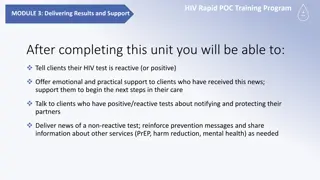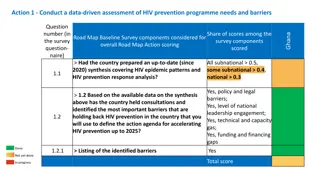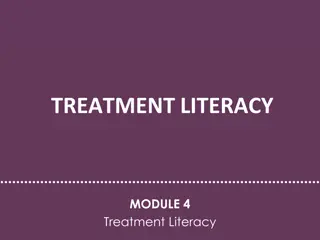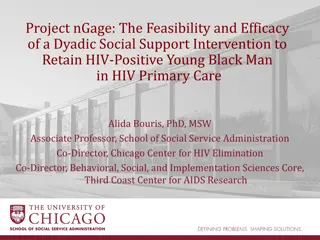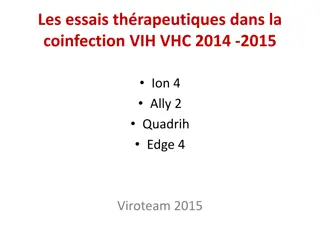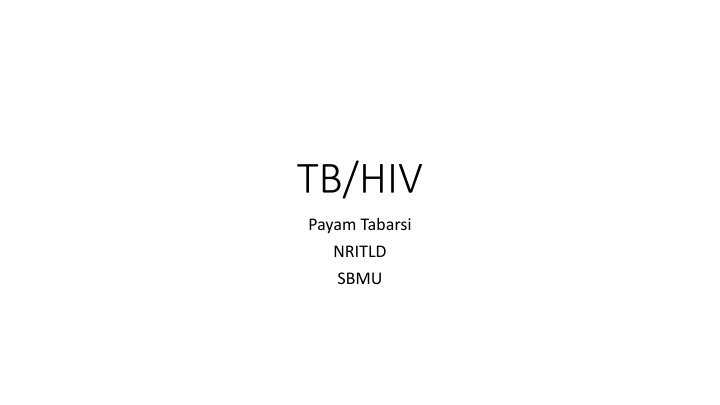
Tuberculosis and HIV Coinfection
Tuberculosis (TB) is a major health concern for individuals living with HIV, leading to significant morbidity and mortality worldwide. This article discusses the relationship between TB and HIV, the risk factors, preventive measures, and the importance of screening and treatment for latent TB infection in HIV-positive individuals.
Download Presentation

Please find below an Image/Link to download the presentation.
The content on the website is provided AS IS for your information and personal use only. It may not be sold, licensed, or shared on other websites without obtaining consent from the author. If you encounter any issues during the download, it is possible that the publisher has removed the file from their server.
You are allowed to download the files provided on this website for personal or commercial use, subject to the condition that they are used lawfully. All files are the property of their respective owners.
The content on the website is provided AS IS for your information and personal use only. It may not be sold, licensed, or shared on other websites without obtaining consent from the author.
E N D
Presentation Transcript
TB/HIV Payam Tabarsi NRITLD SBMU
Tuberculosis (TB) is the leading cause of morbidity and mortality among people with HIV worldwide. In 2019, an estimated 820,000 people with HIV had TB and 208,000 deaths among people with HIV were attributed to TB People with HIV still account for a disproportionate number of TB deaths worldwide (14.7% of deaths vs. 8.2% of TB cases); however, a 69 percent reduction in deaths has occurred since 2000
Persons with LTBI are asymptomatic and are not infectious. TB disease (defined as clinically active disease, often with positive smears and cultures) can develop soon after exposure to M. tuberculosisorganisms (primary disease) or after reactivation of latent infection. The annual risk of TB disease due to reactivation of LTBI for persons with untreated HIV infection has been estimated as 3 percent to 16 percent per year, which approximates the lifetime risk of TB disease for persons with LTBI who are HIV negative (approximately 5%)
The risk of TB begins in the first year following HIV infection. TB infection can occur at any CD4 T lymphocyte (CD4) cell count, although the risk increases with progressive immunodeficiency. Even with effective ART, the risk of TB disease among people with HIV remains greater than that among the general population.
The risk of progression from LTBI to TB disease in persons with HIV is reduced both by ART and by treatment of LTBI. In combination with ART, isoniazid preventive therapy decreased the risk of TB disease by 76 percent among people with HIV in Brazil. Furthermore, isoniazid preventive therapy and ART independently and additively decreased the risk of death and severe HIV-related illness.
All persons with HIV should be evaluated for LTBI at the time of HIV diagnosis, regardless of their epidemiological risk of TB exposure The two current diagnostics available for detection of M. tuberculosis infection in the United States, IGRA and TST, help differentiate those with and without TB infection.
Persons with advanced HIV infection (CD4 count <200 cells/mm3) and negative diagnostic tests for LTBI, without indications for initiating empiric LTBI treatment (i.e., no recent exposure to a culture-confirmed TB case), should be retested for LTBI once they start ART and attain a CD4 count 200 cells/mm3to ensure that the initial test result was a true negative result. Annual testing for LTBI using TST or IGRA is recommended only for people with HIV who have a history of a negative test for infection and are at high risk for repeated or ongoing exposure to persons with active TB disease (e.g., during incarceration, travel to a high-TB incidence country, homelessness, living in a congregate setting)
Traditionally, LTBI has been defined by the presence of a positive TST ( 5 mm of induration at 48 72 hours in people with HIV) in persons with no clinical or radiographic evidence of TB disease. Despite the extensive experience with the TST among people with HIV, the test has several disadvantages: the requirement for two visits to place and read the test, decreased specificity (false positive results) among persons who received Bacillus Calmette-Gu rin (BCG) vaccination, and decreased sensitivity (false negative results) among persons with advanced immunodeficiency
Older studies suggest that IGRAs generally have higher specificity than the TST, may correlate better with exposure to M. tuberculosis, and are less likely to cross-react with BCG vaccination or exposure to other nontuberculous mycobacteria. Furthermore, in a prospective study of 1,510 people with HIV in the United States, IGRAs appeared more sensitive than the TST, although both TST and IGRA (using U.S. cutoffs of 5 mm for TST and 0.35 IU/mL for QuantiFeron-TB Gold In-Tube [QFT-GIT]) may result in more LTBI overdiagnosis than underdiagnosis in a population with 5 percent or lower LTBI prevalence
Some experts have suggested using both the TST and an IGRA in a stepwise or sequential manner to screen for LTBI, but the predictive value of this approach is not clear, and its adoption may be challenging to implement. The routine use of both TST and IGRAs in a single patient to screen for LTBI is not recommended in the United States
As tests of immune reactivity against M. tuberculosis, the TST and IGRAs are often positive among persons with TB disease. Therefore, all persons with a positive TST or IGRA should be evaluated for the possibility of active TB disease. Most, but not all, people with HIV with TB disease have symptoms (e.g., cough, fever, sweats, weight loss, lymphadenopathy); Absence of any of these symptoms had a 97 percent negative predictive value for culture-positive TB in low-resource settings, although this varied depending on pretest probability
The addition of a chest radiograph improved sensitivity of this screening algorithm but decreased specificity. It is important to note that in a symptomatic patient with clinical suspicion for TB disease, a negative TST or IGRA does not rule out TB disease. Obtaining a sputum culture is the gold standard for diagnosing pulmonary TB disease, but it is not high yield in screening people with HIV without pulmonary symptoms, particularly in low-prevalence settings. Therefore, a negative symptom screen (including absent cough of any duration) coupled with a normal chest radiograph is usually sufficient to exclude TB disease in a patient with a positive TST or IGRA
Once active TB disease is excluded and in the absence of other medical contraindications, people with HIV with a positive TB screening test should receive LTBI treatment unless there is documentation of prior treatment for active TB or LTBI. Additionally, people with HIV who are in close contact with anyone with infectious TB should receive LTBI treatment, regardless of their TB screening test results . people with HIV who have been treated successfully for LTBI should not have repeat testing with TST or IGRA; a previously positive test result generally will not revert to negative.
LTBI treatment and ART act independently to decrease the risk of TB disease. Therefore, use of both interventions is recommended for persons with LTBI . Given the important drug drug interactions between rifamycins and several antiretroviral (ARV) agents, selection of an LTBI regimen will depend on a patient s current or planned ARV regimen. Deferring ART until after completion of treatment for LTBI is not recommended
people with HIV should have serum aspartate aminotransferase (AST) or alanine aminotransferase (ALT) and total bilirubin levels measured before starting LTBI treatment and repeated if abnormal. Persons with concomitant chronic viral hepatitis and older individuals have an increased risk of isoniazid-related hepatotoxicity, and such patients should be monitored closely when being treated for LTBI.
If the serum ALT or AST levels increase to greater than five times the upper limit of normal without symptoms or greater than three times the upper limit of normal with symptoms (or greater than two times the baseline value for patients with baseline abnormal transaminases), LTBI treatment should be stopped
CLINICAL MANIFESTATION Similar to persons without HIV infection, people with HIV with TB disease may be asymptomatic but have positive sputum cultures (subclinical TB). In ambulatory people with HIV, the presence of any one of the classic symptoms of TB disease (i.e., cough, hemoptysis fever, night sweats, weight loss) has high sensitivity but low specificity for diagnosing TB as assessed in resource-limited settings. The sensitivity of classic TB symptoms is lower in people with HIV on ART. The presentation of TB disease is influenced by the degree of immunodeficiency. In patients with CD4 counts >200 cells/mm3, HIV-related TB generally resembles TB among persons without HIV. Most patients have disease limited to the lungs, and common chest radiographic manifestations are upper lobe infiltrates with or without cavitation.
In patients with CD4 counts <200 cells/mm3, the chest radiographic findings of pulmonary TB are markedly different, with infiltrates showing no predilection for the upper lobes, and cavitation is uncommon. Normal chest radiographs are not uncommon in patients with respiratory symptoms and positive sputum cultures. Thoracic CT scans may demonstrate mild reticulonodular infiltrates despite a normal chest radiograph
With increasing degrees of immunodeficiency, extrapulmonary (especially lymphadenitis, pleuritis, pericarditis, and meningitis) or disseminated TB are more common. In patients who are markedly immune-suppressed, TB can be a severe systemic disease with high fevers, rapid progression, and features of sepsis. Clinical manifestations of extrapulmonary TB in people with HIV are not substantially different from those described in persons without HIV. TB must be considered in disease processes involving any site in the body, especially in patients with central nervous system (CNS) disease, when early TB treatment is essential to improve outcomes
Initial diagnostic testing for TB disease should be directed at the anatomic site of symptoms or signs (e.g., lungs, lymph nodes, urine, cerebrospinal fluid). Pulmonary involvement is common at all CD4 counts. The initial evaluation of a patient suspected of having HIV-related TB should always include chest imaging, even in the absence of pulmonary symptoms or signs. However, chest radiography is an imperfect screen for pulmonary TB, particularly among patients with advanced immunodeficiency who can have TB culture-positive sputum despite normal chest radiographs. Therefore, sputum smear, nucleic acid amplification (NAA) testing, and culture should be performed in people with HIV with symptoms of TB disease who have a normal chest radiograph, as well as in persons with no pulmonary symptoms but evidence of TB disease elsewhere in the body.
Sputum smear-negative, culture-positive TB disease is common among people with HIV, particularly those with advanced immunodeficiency and non-cavitary disease. However, NAA tests have a higher sensitivity than smear, and the yield of sputum culture is not affected by HIV or the degree of immunodeficiency. Smear and culture of three sputum specimens is recommended based on a large study in patients with HIV that showed a 10 percent incremental yield for broth culture between the second and third specimens
Lymph node involvement is common in HIV-related TB, and the combined yield of histopathology, smear, and culture from needle aspirates of enlarged lymph nodes is quite high. Histopathologic findings also are affected by the degree of immunodeficiency. Persons with relatively intact immune function have typical granulomatous inflammation associated with TB disease. With progressive immunodeficiency, granulomas become poorly formed or can be completely absent.
Pleural fluid, pericardial fluid, ascites, and cerebrospinal fluid should be sampled if clinical evidence of involvement exists. The CDC Infectious Diseases Pathology Branch offers polymerase chain reaction (PCR) testing to aid with molecular identification ofM. tuberculosis on both fresh and formalin-fixed tissue. Among patients with advanced immunodeficiency, the yield of culture from these two readily available body fluids can be relatively high and may allow definitive diagnosis and be the only source of an isolate for drug-susceptibility testing (DST).
NAA tests provide rapid diagnosis of TB, and some assays also provide rapid detection of drug resistance. NAA assays, if positive, are highly predictive of TB disease when performed on Acid- Fast Bacillus (AFB) smear-positive specimens. However, because nontuberculous mycobacterial infections (NTM) may occur in people with HIV with advanced immunodeficiency, negative NAA results in the setting of smear-positive specimens may indicate NTM infection and can be used to direct therapy and make decisions about the need for respiratory isolation.
NAA tests are more sensitive than AFB smear, being positive in 50 percent to 80 percent of smear-negative, culture-positive specimens and up to 90 percent when three NAA tests are performed. Therefore, it is recommended that for all patients with suspected pulmonary TB, a NAA test be performed on at least one specimen. NAA tests also can be used on extrapulmonary specimens with the caveat that the sensitivity is often lower than with sputum specimens
The XpertMTB/RIF assay is an automated NAA test that can detect both M. tuberculosisand mutations in the rpoB gene associated with rifampin resistance. It has been implemented widely in resource- limited settings with high TB prevalence and as a frontline TB diagnostic test in patients with HIV. This assay combines simple processing requirements in the laboratory and rapid turnaround (results within 2 hours)
The assay is somewhat less sensitive among people with HIV (pooled sensitivity of 80%; 95% CI, 67% to 88%) than among patients without HIV (pooled sensitivity of 89%; 95% CI, 81% to 94%);however, this may be, in part, attributed to a higher prevalence of smear-negative disease in people with HIV
Xpert MTB/RIF sensitivity in extrapulmonary specimens is up to 95 percent in smear-positive specimens and 69 percent in smear- negative specimens. Median sensitivity varied by specimen type, with higher yield from lymph nodes (96%), cerebrospinal fluid (85%), and gastric aspirates (78%) and lower yield from pleural fluid (34%) and other non- pleural serous fluids (67%). Xpert MTB/RIF also has been applied with excellent diagnostic accuracy to stool specimens in people with pulmonary TB,which may provide an alternative for those people with HIV who are being evaluated for TB and unable to expectorate.
Lipoarabinomannan (LAM) LAM is an M. tuberculosiscell wall polysaccharide that can be detected in the urine of people with TB. LAM has been shown to be more sensitive and specific as an adjunct diagnostic test in people with HIV with advance immunosuppression
Drug resistance should be considered in all people with HIV, especially those who meet any of the following criteria: Known exposure to a person with drug-resistant TB, Residence in a setting with high rates of primary drug-resistant TB, Persistently positive smear or culture results at or after 4 months of treatment, or Previous TB treatment, particularly if it was not directly observed or was interrupted for any reason
Rapid molecular DST for isoniazid and rifampin should be performed on the initial isolates from all patients suspected of having TB, because resistance to isoniazid or rifampin is associated with an increased risk of treatment failure, recurrent TB, and amplification of resistance to additional TB medications
The presence of multidrug-resistant TB (MDR TB; defined as resistance to at least isoniazid and rifampin) or extensively drug- resistant TB (XDR TB; defined as MDR TB with additional resistance to a fluoroquinolone and either kanamycin, amikacin, or capreomycin) is associated with a markedly increased risk of death. Therefore, early identification of drug resistance, with appropriate adjustment of the treatment regimen based on both full molecular and conventional DST results, is critical to the successful treatment of TB disease and to curbing transmission of drug-resistant M. tuberculosis
TB among persons with advanced immunodeficiency can be a rapidly progressive and fatal illness if treatment is delayed. Therefore, after collection of available specimens for culture and molecular diagnostic tests, empiric treatment for TB is recommended in patients with clinical and radiographic findings suggestive of HIV-related TB
Treatment of TB for people with HIV is the same as for individuals without HIV and should include an initial four-drug combination of isoniazid, rifampin, ethambutol, and pyrazinamide
If rapid DST results indicate resistance to rifampin, with or without resistance to other drugs, an initial MDR TB regimen, as indicated below, should be used and adjusted as molecular sequencing and conventional DST results become available Extension of therapy to 9 months is recommended for patients who have a positive sputum culture after 2 months of treatment or severe cavitary or disseminated extrapulmonary disease . Most extrapulmonary TB can be treated for 6 months, but TB meningitis should be treated for 9 to 12 months
Adjunctive corticosteroid therapy is recommended in individuals with HIV who have TB involving the CNS (AII)and should include dexamethasone (0.3 0.4 mg/kg/day for 2 4 weeks, then taper by 0.1 mg/kg per week until dose of 0.1 mg/kg, then 4 mg per day and taper by 1 mg/week) for a total duration of 12 weeks Adjunctive corticosteroid therapy is not recommended in the treatment of TB pericarditis
ART is recommended for all people with HIV with TB . For ART-naive patients, ART should be started within 2 weeks after TB treatment initiation in those with CD4 count <50 cells/mm3when TB meningitis is not suspected and within 8 weeks of starting anti- TB treatment in those with higher CD4 cell counts
Guidelines recommend that patients with TB meningitis should not start ART before 8 weeks of TB treatment is completed, regardless of CD4 count Many experts recommend that in people with HIV with TB meningitis, ART should be initiated within the first 2 to 8 weeks after starting anti-TB treatment, opting for the first 2 weeks in those with CD4 counts <50 cells/mm3in settings where close monitoring of drug-related toxicities and CNS adverse events is feasible
When TB occurs in patients already on ART, treatment for TB must be started immediately and ART should be modified to reduce the risk for drug interactions and to maintain virologic suppression. When TB occurs in the setting of virologic failure, ART drug-resistance testing should be performed, and intensified adherence counseling should be provided. A new ARV regimen may be required to achieve virologic suppression and minimize drug interactions with the anti-TB regimen
Guidelines ranked the second-line drugs and recommend an initial regimen containing bedaquiline, linezolid, levofloxacin/moxifloxacin, clofazimine, and cycloserine/terizidone. All remaining drugs were placed in a lower tier to complete the regimen only when the recommended drugs cannot be used. Notably, kanamycin and capreomycin are no longer recommended because an increased risk of treatment failure and relapse is seen with their use. Such an association was not seen for amikacin, which may be used when other, less toxic drugs cannot be used. For people with HIV with MDR TB, several important drug drug interactions occur between bedaquilineand some ARV drugs. Specifically, efavirenz decreases bedaquilineplasma concentrations. For people with HIV with MDR TB, efavirenz should not be usedconcurrently with bedaquiline. Lopinavir/ritonavir increases bedaquilineplasma concentrations approximately twofold when given at steady-state, but the clinical significance of this increase is not yet known
Although randomized clinical trial data to guide the optimal timing for ART initiation are lacking, the WHO recommends ART for all patients with HIV and drug-resistant TB, irrespective of CD4 cell count, as early as possible (within the first 8 weeks), following the initiation of TB treatment.
TB-IRIS is a frequent, early complication of ART in people with HIV with active TB. The condition is thought to result from the recovering immune system s driving inflammatory reactions directed at M. tuberculosis antigen present at sites of disease. TB-IRIS is characterized by excessive local or systemic inflammation. Two forms of TB-IRIS are recognized: paradoxical TB- IRIS and unmasking TB-IRIS

